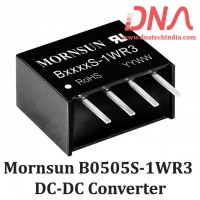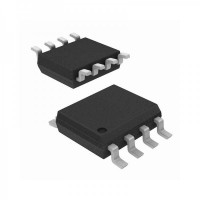Position Sensors |
||
| In this tutorial we will look at a variety of devices which are classed as Input Devices and are therefore called "Sensors" and in particular those sensors which are Positional in nature which means that they are referenced either to or from some fixed point or position. As their name implies, these types of sensors provide a "position" feedback. | ||
| One method of determining a position, is to use either "distance", which could be the distance between two points such as the distance travelled or moved away from some fixed point, or by "rotation" (angular movement). For example, the rotation of a robots wheel to determine its distance travelled along the ground. Either way,can detect the movement of an object in a straight line using Linear Sensors or by its angular movement using Rotational Sensors | ||
The Potentiometer. |
||
|
The most commonly used of all the "Position Sensors", is the potentiometer because it is an inexpensive and easy to use position sensor. It has a wiper contact linked to a mechanical shaft that can be either angular (rotational) or linear (slider type) in its movement, and which causes the resistance value between the wiper/slider and the two end connections to change giving an electrical signal output that has a proportional relationship between the actual wiper position on the resistive track and its resistance value. In other words, resistance is proportional to position. |
||
|
Potentiometers come in a wide range of designs and sizes such as the commonly available round rotational type or the longer and flat linear slider types. When used as a positional sensor the moveable object is connected directly to the shaft or slider of the potentiometer and a DC reference voltage is applied across the two outer fixed connections forming the resistive element. The output voltage signal is taken from the wiper terminal of the sliding contact as shown below.
this configuration produces a potential or voltage divider type circuit output which is proportional to the shaft position. Then for example, if you apply a voltage of say 10v across the resistive element of the potentiometer the maximum output voltage would be equal to the supply voltage at 10 volts, with the minimum output voltage equal to 0 volts. Then the potentiometer wiper will vary the output signal from 0 to 10 volts, with 5 volts indicating that the wiper or slider is at its half-way or centre position. |
||
Potentiometer Construction |
||
|
|
||
|
The output signal (Vout) from the potentiometer is taken from the centre wiper connection as it moves along the resistive track, and is proportional to the angular position of the shaft. |
||
Example of a simple Positional Sensing Circuit |
||
|
While resistive potentiometer position sensors have many advantages: low cost, low tech, easy to use etc, as a position sensor they also have many disadvantages: wear due to moving parts, low accuracy, low repeatability, and limited frequency response. |
||
|
But there is one main disadvantage of using the potentiometer as a positional sensor. The range of movement of its wiper or slider (and hence the output signal obtained) is limited to the physical size of the potentiometer being used. For example a single turn rotational potentiometer generally only has a fixed electrical rotation between about 240 to 330 however, multi-turn pots of up to 3600 o of electrical rotation are also available. Most types of potentiometers use carbon film for their resistive track, but these types are electrically noisy (the crackle on a radio volume control), and also have a short mechanical life. |
||
|
Wire-wound pots also known as rheostats, in the form of either a straight wire or wound coil resistive wire can also be used, but wire wound pots suffer from resolution problems as their wiper jumps from one wire segment to the next producing a logarithmic (LOG) output resulting in errors in the output signal. These too suffer from electrical noise. |
||
|
For high precision low noise applications conductive plastic resistance element type polymer film or cermet type potentiometers are now available. These pots have a smooth low friction electrically linear (LIN) resistive track giving them a low noise, long life and excellent resolution and are available as both multi-turn and single turn devices. Typical applications for this type of high accuracy position sensor is in computer game joysticks, steering wheels, industrial and robot applications. |
||
Inductive Position Sensors. |
||
Linear Variable Differential Transformer |
||
|
One type of positional sensor that does not suffer from mechanical wear problems is the "Linear Variable Differential Transformer" or LVDT for short. This is an inductive type position sensor which works on the same principle as the AC transformer that is used to measure movement. It is a very accurate device for measuring linear displacement and whose output is proportional to the position of its moveable core. |
||
|
It basically consists of three coils wound on a hollow tube former, one forming the primary coil and the other two coils forming identical secondaries connected electrically together in series but 180 o out of phase either side of the primary coil. A moveable soft iron ferromagnetic core (sometimes called an "armature") which is connected to the object being measured, slides or moves up and down inside the tube. A small AC reference voltage called the "excitation signal" (2 - 20V rms, 2 - 20kHz) is applied to the primary winding which inturn induces an EMF signal into the two adjacent secondary windings (transformer principles). |
||
|
If the soft iron magnetic core armature is exactly in the centre of the tube and the windings, "null position", the two induced emf's in the two secondary windings cancel each other out as they are 180o out of phase, so the resultant output voltage is zero. As the core is displaced slightly to one side or the other from this null or zero position, the induced voltage in one of the secondaries will be become greater than that of the other secondary and an output will be produced. |
||
|
The polarity of the output signal depends upon the direction and displacement of the moving core. The greater the movement of the soft iron core from its central null position the greater will be the resulting output signal. The result is a differential voltage output which varies linearly with the cores position. Therefore, the output signal has both an amplitude that is a linear function of the cores displacement and a polarity that indicates direction of movement. |
||
|
The phase of the output signal can be compared to the primary coil excitation phase enabling suitable electronic circuits such as the AD592 LVDT Sensor Amplifier to know which half of the coil the magnetic core is in and thereby know the direction of travel. |
||
The Linear Variable Differential Transformer |
||
|
|
||
| When the armature is moved from one end to the other through the centre position the output voltages changes from maximum to zero and back to maximum again but in the process changes its phase angle by 180 deg's. This enables the LVDT to produce an output AC signal whose magnitude represents the amount of movement from the centre position and whose phase angle represents the direction of movement of the core. | ||
| A typical application of a linear variable differential transformer (LDVT) sensor would be as a pressure transducer, were the pressure being measured pushes against a diaphragm to produce a force. The force is then converted into a readable voltage signal by the sensor. | ||
| Advantages of the linear variable differential transformer, or LVDT compared to a resistive potentiometer are that its linearity, that is its voltage output to displacement is excellent, very good accuracy, good resolution, high sensitivity as well as frictionless operation. They are also sealed for use in hostile environments. | ||
Inductive Proximity Sensors. |
||
| Another type of inductive sensor in common use is the Inductive Proximity Sensor also called an Eddy current sensor. While they do not actually measure displacement or angular rotation they are mainly used to detect the presence of an object in front of them or within a close proximity, hence the name proximity sensors. | ||
| Proximity sensors, are non-contact devices that use a magnetic field for detection with the simplest magnetic sensor being the reed switch. In an inductive sensor, a coil is wound around an iron core within an electromagnetic field to form an inductive loop. | ||
| When a ferromagnetic material is placed within the eddy current field generated around the inductive sensor, such as a ferromagnetic metal plate or metal screw, the inductance of the coil changes significantly. The proximity sensors detection circuit detects this change producing an output voltage. Therefore, inductive proximity sensors operate under the electrical principle of Faraday's Law of inductance. | ||
Inductive Proximity Sensors |
||
|
|
||
| An inductive proximity sensor has four main components; The oscillator which produces the electromagnetic field, the coil which generates the magnetic field, the detection circuit which detects any change in the field when an object enters it and the output circuit which produces the output signal, either with normally closed (NC) or normally open (NO) contacts. Inductive proximity sensors allow for the detection of metallic objects in front of the sensor head without any physical contact of the object itself being detected. This makes them ideal for use in dirty or wet environments. The "sensing" range of proximity sensors is very small, typically 0.1mm to 12mm. |
| As well as industrial applications, inductive proximity sensors are also used to control the changing of traffic lights at junctions and cross roads. Rectangular inductive loops of wire are buried into the tarmac road surface and when a car or other road vehicle passes over the loop, the metallic body of the vehicle changes the loops inductance and activates the sensor thereby alerting the traffic lights controller that there is a vehicle waiting. |  |
| One main disadvantage of these types of sensors is that they are "Omni-directional", that is they will sense a metallic object either above, below or to the side of it. Also, they do not detect non-metallic objects although Capacitive Proximity Sensors and Ultrasonic Proximity Sensors are available. Other commonly available magnetic position sensor include: reed switches, hall effect sensors and variable reluctance sensors. | ||
Rotary Encoders. |
||
|
Rotary Encoders resemble potentiometers mentioned earlier but are non-contact optical devices used for converting the angular position of a rotating shaft into an analogue or digital data code. In other words, they convert mechanical movement into an electrical signal (preferably digital). All optical encoders work on the same basic principle. Light from an LED or infra-red light source is passed through a rotating high-resolution encoded disk that contains the required code patterns, either binary, grey code or BCD. Photo detectors scan the disk as it rotates and an electronic circuit processes the information into a digital form as a stream of binary output pulses that are fed to counters or controllers which determine the actual angular position of the shaft. There are two basic types of rotary optical encoders, Incremental Encoders and Absolute Position Encoders. |
||
Incremental EncoderIncremental Encoders, also known as quadrature encoders or relative rotary encoder, are the simplest of the two position sensors. Their output is a series of square wave pulses generated by a photocell arrangement as the coded disk, with evenly spaced transparent and dark lines called segments on its surface, moves or rotates past the light source. The encoder produces a stream of square wave pulses which, when counted, indicates the angular position of the rotating shaft. |
 |
| The number of transparent and dark segments or slots on the disk determines the resolution of the device and increasing the number of lines in the pattern increases the resolution per degree of rotation. Typical encoded discs have a resolution of up to 256 pulses or 8-bits per rotation. | ||
| The simplest incremental encoder is called a tachometer. It has one single square wave output and is often used in unidirectional applications where basic position or speed information only is required. The "Quadrature" or "Sine wave" encoder is the more common and has two output square waves commonly called channel A and channel B. This device uses two photo detectors, slightly offset from each other by 90o thereby producing two separate sine and cosine output signals. | ||
Simple Incremental Encoder |
||
|
|
||
| By using the Arc Tangent mathematical function the angle of the shaft in radians can be calculated. Generally, the optical disk used in rotary position encoders is circular, then the resolution of the output will be given as: θ = 360/n, where n equals the number of segments on coded disk. Then for example, the number of segments required to give an incremental encoder a resolution of 1o will be: 1o = 360/n, therefore, n = 360 windows, etc. Also the direction of rotation is determined by noting which channel produces an output first, either channel A or channel B giving two directions of rotation, A leads B or B leads A. This arrangement is shown below. | ||
Incremental Encoder Output |
||
|
|
||
| One main disadvantage of incremental encoders when used as a position sensor, is that they require external counters to determine the absolute angle of the shaft within a given rotation. If the power is momentarily shut off, or if the encoder misses a pulse due to noise or a dirty disc, the resulting angular information will produce an error. One way of overcoming this disadvantage is to use absolute position encoders. | ||
Absolute Position Encoder |
||
| Absolute Position Encoders are more complex than quadrature encoders. They provide a unique output code for every single position of rotation indicating both position and direction. Their coded disk consists of multiple concentric "tracks" of light and dark segments. Each track is independent with its own photo detector to simultaneously read a unique coded position value for each angle of movement. The number of tracks on the disk corresponds to the binary "bit"-resolution of the encoder so a 12-bit absolute encoder would have 12 tracks and the same coded value only appears once per revolution. | ||
4-bit Binary Coded Disc |
||
|
|
||
|
One main advantage of an absolute encoder is its non-volatile memory which retains the exact position of the encoder without the need to return to a "home" position if the power fails. Most rotary encoders are defined as "single-turn" devices, but absolute multi-turn devices are available, which obtain feedback over several revolutions by adding extra code disks. Typical application of absolute position encoders are in computer hard drives and CD/DVD drives were the absolute position of the drives read/write heads are monitored or in printers/plotters to accurately position the printing heads over the paper. In this tutorial about Position Sensors, we have looked at several examples of sensors that can be used to measure the position or presence of objects. In the next tutorial we will look at sensors that are used to measure temperature such as thermistors, thermostats and thermocouples. |
|
Reproduced with permission from Wayne Storr |










